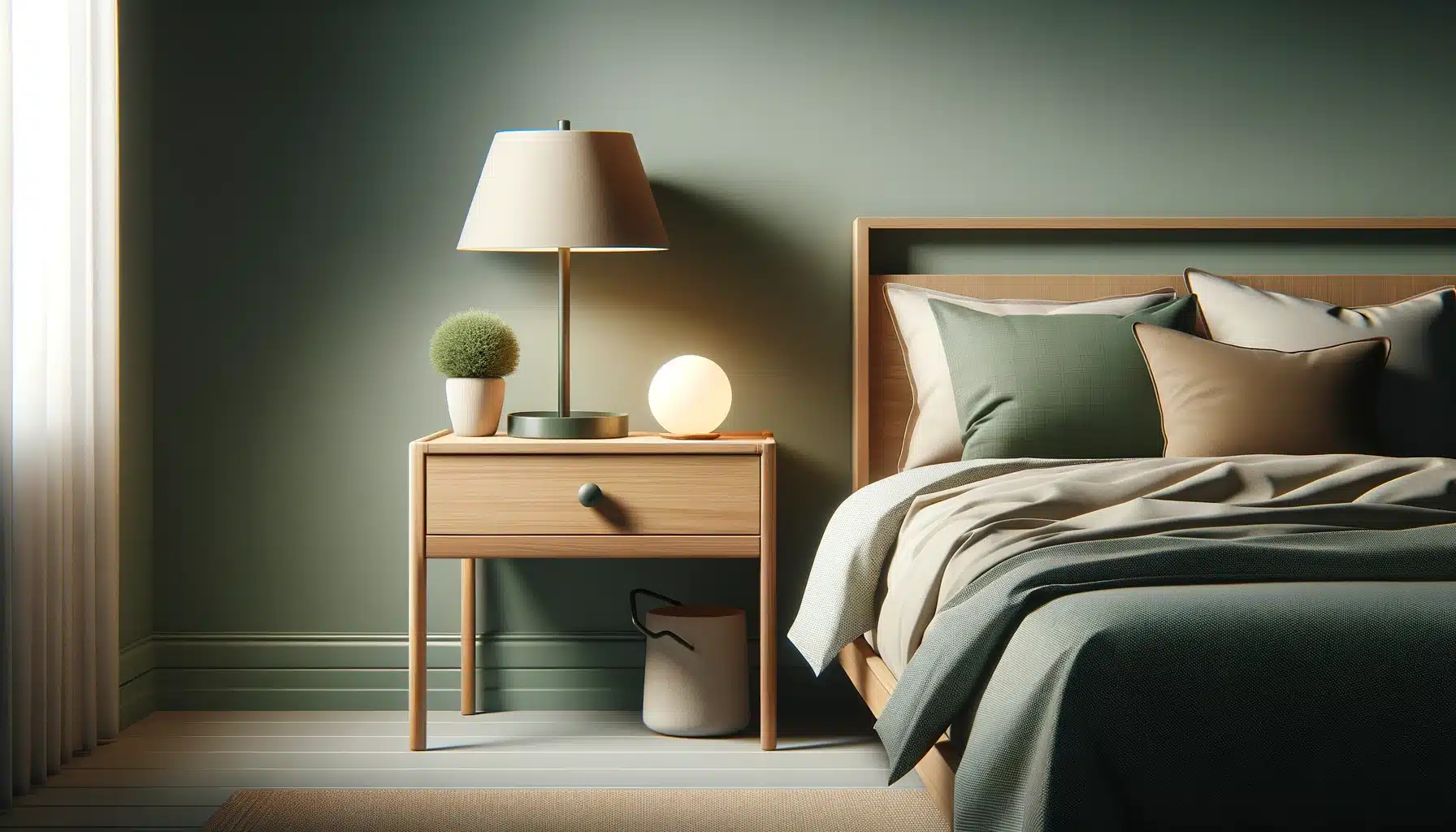Introduction
When it comes to designing the perfect bedroom, every detail counts – from the softness of your sheets to the height of your nightstand. While the former contributes to a good night’s sleep, the latter enhances both functionality and style within your personal sanctuary. But how tall should a nightstand be? This seemingly simple question holds the key to a harmonious bedroom setup, where convenience meets design.
The right nightstand height not only ensures that your essentials are within arm’s reach but also maintains a visual balance alongside your bed. It complements your bed’s height, supports your bedside lamp at just the right level, and contributes to an overall aesthetic that feels both intentional and inviting. With varying bed heights and nightstand designs available, finding that perfect match might seem daunting. Yet, understanding a few basic principles can transform this challenge into an opportunity to elevate your bedroom’s design.
Quick Read: How Tall Should Your Nightstand Be?
Ideally, your nightstand should be roughly equal to your mattress height, give or take a couple of inches. This rule of thumb ensures that everything you need is within easy reach and that your bedside lamp sheds light efficiently without straining your eyes.
Why does this matter? A nightstand too tall or too short compared to your bed can disrupt the harmony of your bedroom design and affect your comfort. Imagine stretching upwards to turn off your alarm or bending down awkwardly to grab your bedtime read; it sounds inconvenient, doesn’t it? That’s because it is. Ensuring your nightstand and bed are proportionately matched also optimizes the functionality of your lamp, casting the perfect glow for your bedtime activities without overpowering or under-lighting your space.
Stay tuned as we delve deeper into why nightstand height is crucial, how to determine the ideal height for your setup, and tips from design experts to make an informed decision for your bedroom.
Why Nightstand Height Matters
A well-chosen nightstand does more than hold your lamp and alarm clock; it’s an integral part of your bedroom’s functionality and style. The height of your nightstand affects several aspects of your bedroom experience:

- Comfort and Convenience: The ideal nightstand height makes it easy to reach for your glass of water, book, or phone without having to stretch or bend awkwardly. It aligns with your mattress, ensuring that everything you need is just a hand’s reach away when you’re lying in bed.
- Room Aesthetics: Proportion plays a crucial role in interior design. A nightstand that’s too high or too low in relation to your bed can disrupt the room’s visual harmony and balance. The right height complements your bed’s dimensions, creating a cohesive and pleasing look.
- Lamp Functionality: The position of your bedside lamp is crucial for optimal lighting. A nightstand at the right height positions the lamp so its light is neither too harsh nor too dim, creating the perfect ambiance for reading or relaxing before sleep.
Understanding these factors highlights the importance of choosing a nightstand of the appropriate height. It’s not just about practicality; it’s about enhancing your overall bedroom experience.
Determining the Ideal Height for Your Nightstand
Finding the perfect nightstand height can dramatically enhance both the functionality and aesthetic of your bedroom. Here’s how you can determine the ideal height for your nightstand, taking into account the height of your bed and lamp:

- Match Nightstand and Mattress Heights: Start by measuring the height of your mattress from the floor to the top of the mattress. Your nightstand should ideally be within a couple of inches of this height. If your mattress sits at 25 inches, look for a nightstand approximately 23 to 27 inches tall. This range ensures that items on your nightstand are easily accessible and that the surface aligns closely with your mattress, creating a unified look.
- Consider Your Lamp Height: The height of your bedside lamp plays a significant role in determining the ideal height for your nightstand. The bottom of the lampshade should be at about eye level when sitting up in bed. This setup prevents the light from shining directly into your eyes and ensures it’s cast evenly across your book or bedside area. If you have a tall lamp, you might opt for a slightly shorter nightstand to balance the overall height and vice versa.
- Adjust for Personal Preference and Special Needs: While the general guidelines provide a good starting point, personal preference and specific needs should guide your final decision. For instance, if you have a particularly thick mattress or use bed risers, you might need a taller nightstand. Conversely, platform beds might call for a shorter model. Consider how you use your nightstand—do you read in bed a lot, requiring easy access to your lamp and books? Or do you primarily need it for storing items within reach? Let your lifestyle and habits influence your choice.
- Test Before You Buy: If possible, test out different nightstand heights in relation to your bed and lamp. Use boxes or books to simulate the height of potential nightstands. This hands-on approach can give you a better sense of what height is most comfortable and visually appealing in your space.
By following these steps, you can find a nightstand that not only complements your bed and lamp but also enhances the overall comfort and style of your bedroom.
Expert Opinions on Nightstand Height
When it comes to selecting the perfect nightstand, professional interior designers emphasize the importance of both form and function. Here’s what some experts have to say about finding the right nightstand height for your bedroom:
- The Rule of Proximity: According to Emily Henderson, a renowned interior designer, “The nightstand should be in close proximity to your mattress height. This doesn’t just add to the room’s aesthetic balance but also enhances practicality. You should be able to grab your book, glass, or turn off the alarm without fully stretching or bending.”
- Consider the Bed’s Scale: Jordan Ferney, the founder of Oh Happy Day and an interior design enthusiast, suggests, “Besides the height, consider the scale of your bed. A large, king-sized bed might dwarf a tiny nightstand. Even if the heights align, the proportions should feel balanced to the eye.”
- Function Over Form: Alex Kalita, a partner at Common Bond Design, advises, “While aesthetics are vital, don’t overlook the functional aspect of your nightstand. If your lamp is particularly tall or short, adjust the height of your nightstand accordingly. The goal is to have the middle of your lampshade at eye level while sitting up in bed.”
- Personalization Is Key: “There’s no one-size-fits-all answer,” states Shea McGee of Studio McGee. “Consider your personal needs and the specific functionality of your nightstand. Whether it’s for reading, storing essentials, or both, your nightstand should cater to your lifestyle.”
These insights highlight a common theme: the ideal nightstand height is not just about measurements but also about personal comfort, the scale of other bedroom furniture, and the intended use. Balancing these elements can create a harmonious and functional bedroom space that reflects your personal style and needs.
Types of Nightstands and Their Typical Heights
Nightstands come in an array of styles, each offering unique benefits and aesthetics. Understanding the typical heights and features of these styles can greatly assist in making the best choice for your bedroom.

- Traditional Nightstands: Usually ranging from 24 to 28 inches in height, traditional nightstands offer a classic look with ample storage space. They often feature drawers or shelves, making them practical for those who like to keep essentials close by. Their height is compatible with most standard bed heights, ensuring ease of access to your belongings.
- Modern Nightstands: Modern nightstands can vary widely in height, typically between 18 to 30 inches, reflecting the diversity in contemporary bed heights. They often boast sleek lines, minimalistic designs, and innovative storage solutions. Choosing a modern nightstand involves considering both the height of your bed and your aesthetic preferences to ensure a cohesive bedroom look.
- Floating Nightstands: Floating nightstands are mounted directly to the wall, offering the flexibility to choose the perfect height for your needs. They are ideal for creating a clean, minimalist aesthetic and work well in small spaces. The recommended height aligns with your mattress top, but the customizable installation allows for adjustments based on personal preference and bed height.
- Adjustable Nightstands: Some nightstands come with adjustable features, allowing you to modify their height as needed. These are particularly useful for beds with adjustable bases or for those who frequently change their mattress type or bedroom layout. While they can vary in design, adjustable nightstands offer a range of heights, typically from 22 to 30 inches.
- Antique Nightstands: For those who prefer a vintage touch, antique nightstands offer unique designs and heights. They tend to be shorter, often around 22 to 26 inches, reflecting the bed heights of past eras. When choosing an antique nightstand, it’s essential to consider how it will match up with the height of your contemporary bed and mattress.
Regardless of the type, the key to selecting the right nightstand is ensuring it meets your functional needs while complementing the overall style and height of your bed. Remember, the ideal nightstand not only adds convenience but also enhances the aesthetic appeal of your bedroom
Conclusion
Selecting the right nightstand height is more than just a detail in your bedroom design—it’s a choice that impacts both aesthetics and functionality. As we’ve explored, the ideal nightstand should align closely with the height of your mattress to ensure ease of access and maintain visual harmony. Whether you opt for a traditional, modern, floating, adjustable, or antique nightstand, the key is to consider the height in relation to your bed and lamp to create a cohesive and comfortable space.
Remember, while general guidelines provide a great starting point, personal preference, and specific needs play a crucial role in making the final decision. The goal is to create a bedroom that not only looks good but also feels right for you. From considering expert opinions to understanding the types of nightstands available, we hope this guide has equipped you with the knowledge to choose the perfect nightstand height for your bedroom.
